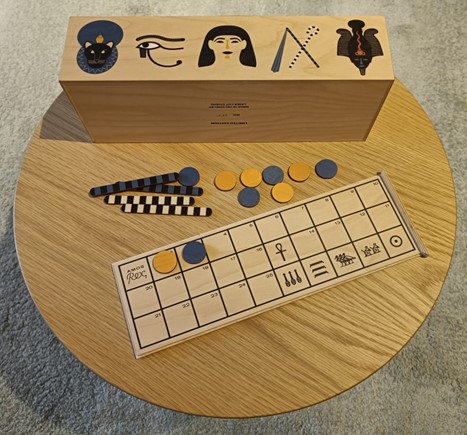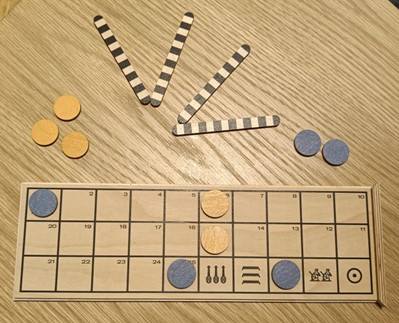Is Saturday evening. “We haven’t played in quite a while”, she said. “Hands full with the kid”, I replied. “Yeah, but I wish we could play something, even if it is Snakes & Ladders”, she answers me back. “Well, we have Senet”, I laughed underestimating the game. “What was that one again? Is it like complicated rules and a big manual? I don´t want that.”, she took it seriously my answer. I am glad she did.
Senet is the first known board game, or at least the oldest that we know about it, with the first boards indicating over 3100 BCE years old. The basic rules are simple: in a 30-space board, the first to reach the last space with all their five pawns wins; you throw sticks to determine how much you can move and there are five special houses in the board. Well, that is not quite correct. The rules of Senet are not known for sure. What we know are deductions based on boards, pictures, and archeological relics found. We played a limited edition from a museum exposition (Amos Rex) but you can find different versions with slight variations of the rules.

In this version, you throw four sticks to determine how many spaces you move. Each stick is painted white on one side and blue on the other. For each blue side up you move one square, but if you get all white then you move five. If you cannot move forward, you must move backward. If you cannot move, you lose your turn. If you roll one, four, or five you throw it again (and that can go on as long the luck is on your side).
Regarding the special houses on the board, there are five in total (excluding the last space as once a pawn reaches there that pawn is just removed from the game). (I) House of Beauty – all pawns must stop here before progressing, (II) House of Water – if a pawn stops here, it goes back to (III) House of Rebirth, (IV) House of Three Truths – players must throw a 3 to continue, and (V) House of Ra-Atum – players must throw a 2 to continue. We added our own rule that in the last space we should throw a 1 and later we discovered that that was one variation of possible rules.
Okay, so far you might be thinking that this is pretty Snake&Ladders-ish. Here is the twist. Two pawns cannot occupy the same space, if they do it instead, they swap places. Remember that I said that if one cannot move forward, it should move backward? The swapping rule also applies here. That itself already makes the game a bit chaotic at times. However, you can protect your pawns and stop that happening by having two pawns in a roll. If you have three pawns in a roll then the other player pawns cannot even pass through them. It is a simple but quite efficient layer of strategy, combine it with that you can move any of your pawns in the board so you can either try to rush to the end one by one and that is fine, or you can try to divide and conquer, split your rolls here and there to make sure all your souls (pawns) gets to the afterlife together.

That is something magical about Senet. Maybe is how old the game is and still holds up okay nowadays, maybe is just my current busy life that I found a way to get back to my hobby again for a little, but might be the simple fact that not every day you see an interesting way to roll a die without a die, and that gets me fascinated every time I get back to the game. Holding the sticks before a throw feels different and I doubt that Senet would be the same just by throwing dice.
If you haven´t played Senet, you should. Probably isn´t going to be the best board game you ever played. Just keep in mind that we are talking about a minimum four-thousand-year-old game. It is easy to analyze with modern eyes and say that is a luck-based game, but Senet is more than that. It is playing through history, it is an invitation to think about game design, it is an invitation for us to undress our modern games and just enjoy something simple.
Basic information
Designer: Mia Meri (reconstructed through the rules of Timothy Kendall)
Publisher: Amos Rex (2020)
Date: 3100 BCE
Number of players: 2
Playing time: 20 min
Age: 6+
